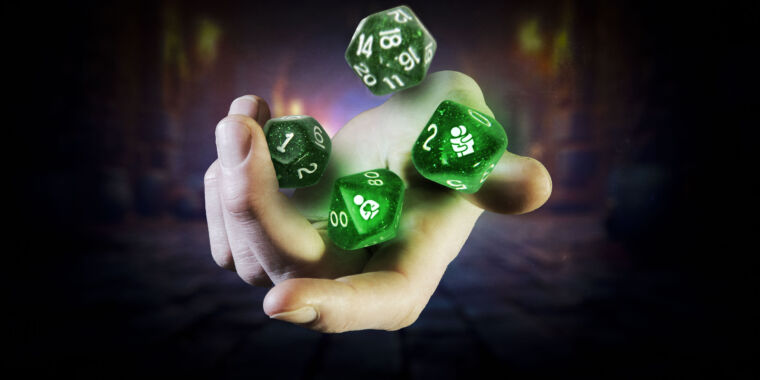Aurich Lawson | Getty Images
This year marks the 50th anniversary of the tabletop role-playing game (TTRPG) Dungeons & Dragons (D&D). A game of creativity and imagination, D&D lets players weave their own narrative, blending combat and roleplaying in an immersive gaming experience. And now, psychologists and therapists are working to turn it into a tool by exploring its potential benefits as a group therapy technique.
Research is still in progress to determine if there are links between playing D&D and enhanced empathy and social skills, but the real-life impact of D&D therapy is slowly gaining traction as staff of counseling practices that have embraced D&D group therapy say they are witnessing these benefits firsthand.
“It seems particularly useful in combating the effects of social isolation and improving both interpersonal skills and intrapersonal skills (problem-solving),” explained Gary Colman, the chairman of Game Therapy UK, a registered charity staffed by volunteer professionals who are developing evidence-based therapeutic gaming projects. “In practical terms, it can also be used for a range of purposes, including modeling positive behavior and teaching soft social skills and basic educational skills, including language and numeracy.”
What is D&D?
At the heart of D&D lies the power of imagination. The Dungeon Master (DM), who plays the roles of all non-player characters (NPCs) and monsters, sets the stage for various scenes and acts to open up the limitless possibilities and creative potential of the game.
Players customize their characters’ abilities and personalities to either participate in a roleplaying session, act out scenes with NPCs to further the story, or engage in combat with terrifying monsters like bugbears or gloomstalkers. Individual gaming sessions can run for multiple hours and, combined, allow players to work through a larger campaign that lasts for weeks or even years.
The game was created in 1974 by Ernest Gary Gygax and Dave Arneson. Gygax’s company, TSR, Inc. (Tactical Studies Rules), steadily grew into a multimillion-dollar business but was plagued by leadership and financial issues for decades. Ultimately, TSR was acquired by its competitor, Wizards of the Coast (the company responsible for Magic: The Gathering) in 1997 (Wizards of the Coast would be acquired by Hasbro in 1999).
While D&D had humble beginnings as a niche fantasy game played only by nerds, its popularity has skyrocketed, partially due to Netflix’s blockbuster show Stranger Things. Since the show’s release in 2016, sales of the game have reached a high not seen in 30 years. Netflix even offered D&D tutorials to Stranger Things fans who wanted to learn to play the game like their favorite characters. The show boosted D&D’s popularity so much that Hasbro released a Stranger Things D&D starter set.
Unlike on previous shows where it has made appearances, such as The X-Files or The Big Bang Theory, D&D is central to the plot of Stranger Things, as it’s played by the show’s main heroes as they try to learn more about the mythical “Upside Down” realm in their town. Monsters and villains like the Demigorgon and Vecna are even named after real D&D baddies.
Stranger Things also accurately portrays the impacts that the 1980s Satanic Panic movement had on D&D. The Satanic Panic was led by religious fundamentalist groups who claimed that D&D promoted worship of the devil, witchcraft, violence, and teen suicides. The backlash against the game was so acute that it was banned from many schools in the early 1980s, and the second edition removed all devils and demons. Ultimately, confirming that there’s no such thing as bad publicity, this helped the game become more popular.

Netflix
Links to the Satanic Panic can be found early in the show, such as the disappearance of Will in season one, which was inspired by the real-life disappearance of Michigan State University student James Dallas Egbert III in August 1979—an event that helped kick off the Satanic Panic movement. While Egbert III reappeared a month later, detectives working the case believed that D&D had inspired Egbert to hide in his school’s steam tunnels, a claim which Egbert III later refuted. Unlike in Stranger Things, where Will is reunited with his family, Egbert III committed suicide a month after his reappearance.
Fast forward to today, and D&D has climbed even higher in popularity thanks to the 2023 multimillion-dollar movie Dungeons & Dragons: Honor Among Thieves, which grossed $200 million, turning a profit despite its $150 million budget.

